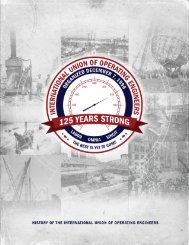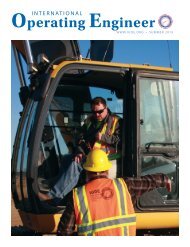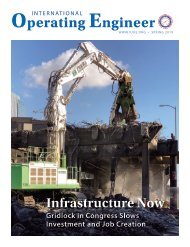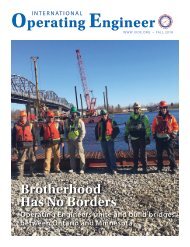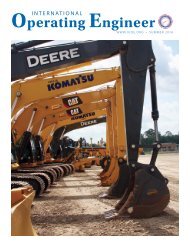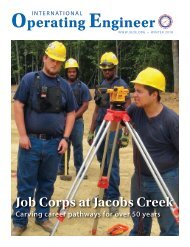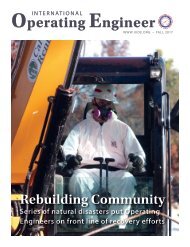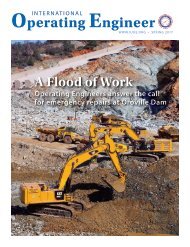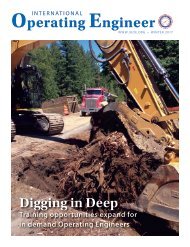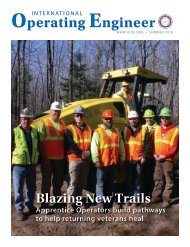International Operating Engineer - Spring 2016
The quarterly magazine of the International Union of Operating Engineers.
The quarterly magazine of the International Union of Operating Engineers.
Create successful ePaper yourself
Turn your PDF publications into a flip-book with our unique Google optimized e-Paper software.
HAZMAT<br />
Deadly Dust: OSHA’s New Silica Rule Will Save Lives<br />
Confined Spaces 101 Mobile App Now Available<br />
THE OCCUPATIONAL SAFETY<br />
AND HEALTH ADMINISTRATION<br />
(OSHA) announced its final rule<br />
in March to improve protection for<br />
workers exposed to respirable silica<br />
dust. The final rule is effective June 23,<br />
<strong>2016</strong>. The rule is written as two different<br />
standards: one for construction 29<br />
CFR 1926.1153 Respirable Crystalline<br />
Silica, and one for general industry<br />
and maritime 1910.1053 Respirable<br />
Crystalline Silica.<br />
Employers covered by the<br />
construction standard have until<br />
Jun 23, 2017 to comply with most<br />
requirements. Employers covered by<br />
the general industry and maritime<br />
standard have until June 23, 2018<br />
to comply with most requirements.<br />
There is additional time to offer<br />
medical exams to some workers and<br />
for hydraulic fracturing employers to<br />
install dust controls to meet the new<br />
exposure limit.<br />
Crystalline silica is a common<br />
mineral found in many naturally<br />
occurring materials like sand, concrete,<br />
stone and mortar. It is also used in<br />
many products like glass, pottery,<br />
ceramics, bricks, concrete and artificial<br />
stone.<br />
Inhaling very small (“respirable”)<br />
crystalline silica particles causes<br />
multiple diseases, including silicosis,<br />
an incurable lung disease that can lead<br />
to disability and death. Respirable<br />
crystalline silica also causes lung<br />
cancer, chronic obstructive pulmonary<br />
disease (COPD) and kidney disease.<br />
PICTURE THIS: You’re<br />
getting ready to tackle a<br />
job and you’re not sure if<br />
it’s a confined space. If it<br />
is, is it safe to enter? What<br />
do you do? The IUOE<br />
NTF National HAZMAT<br />
Program recently released<br />
a Confined Spaces 101 app<br />
that can help.<br />
Following OSHA’s<br />
guidelines and the Decision Flow<br />
Chart for the general industry found<br />
in OSHA regulation 29 CFR 1910.146,<br />
the app provides general guidance<br />
through questions and steps that need<br />
to be taken to help you decide whether<br />
the space is safe for entry or is a permitrequired<br />
confined space. Additional<br />
features include definitions, workers’<br />
notes, and additional<br />
references.<br />
Available for both<br />
Apple (iTunes) and<br />
Android (Google<br />
Play) devices, the<br />
app can be used<br />
without an Internet<br />
connection after it<br />
has been successfully<br />
downloaded. So if<br />
you’re at a remote jobsite, in a big city,<br />
or even at home, you will be able to use<br />
this app wherever and whenever you<br />
need it.<br />
Go to any search engine and type<br />
“Confined Spaces 101” and the logo<br />
above will appear.<br />
What does the silica Construction Standard require?<br />
About 2 million construction workers are exposed to respirable crystalline silica in over 600,000 workplaces.<br />
OSHA estimates that more than 840,000 of these workers are exposed to silica levels that exceed the new<br />
permissible exposure limit (PEL). The new PEL is 50 micrograms/cubic meter of air. The standard requires<br />
employers to limit worker exposures to respirable crystalline silica and to take other steps to protect workers.<br />
Employers can either use a control method laid out in Table 1 of the construction standard (see regulatory<br />
text and table 1 at www.osha.gov/silica/SilicaConstructionRegText.pdf), or they can measure workers’<br />
exposure to silica and independently decide which dust controls work best to limit exposures to the PEL in<br />
their workplaces.<br />
Regardless of which exposure control method is used, all construction employers covered by the standard<br />
are required to:<br />
• Establish and implement a written exposure control plan that identifies tasks that involve exposure<br />
and identifies methods used to protect workers. This includes procedures to restrict access to work<br />
areas where high exposure may occur.<br />
• Designate a competent person to implement the exposure control plan.<br />
• Restrict housekeeping practices that expose workers to silica where feasible alternatives are available.<br />
• Offer medical exams every 3 years for workers who are to wear a respirator for 30 or more days per<br />
year.<br />
• Train workers on work operations that result in silica exposure and ways to limit exposure.<br />
• Keep records of workers’ silica exposure and medical exams.<br />
What does the silica General Industry and Maritime standard require?<br />
About 295,000 workers are exposed to respirable crystalline silica in over 75,000 general industry and<br />
maritime workplaces. OSHA estimates that over 100,000 workers are exposed to silica levels that exceed the<br />
new PEL of 50 micrograms/cubic meter of air.<br />
The standard for general industry and maritime requires employers to:<br />
• Measure the amount of silica that workers are exposed to if it may be at or above the action level of<br />
25 micrograms/cubic meter of air averaged over an 8-hour day.<br />
• Protect workers from silica exposure above the PEL of 50 micrograms/cubic meter of air averaged<br />
over an 8-hour day.<br />
• Limit workers’ access to areas where they could be exposed above the PEL.<br />
• Provide respirators to workers when dust controls cannot limit exposures to the PEL.<br />
• Restrict housekeeping practices that expose workers to silica where feasible alternatives are available.<br />
• Establish and implement a written exposure control plan that identifies tasks that involve exposure<br />
and methods used to protect workers.<br />
• Offer medical exams every 3 years for workers exposed at or above the action level for 30 or more<br />
days per year.<br />
• Train workers on work operations that result in silica exposure and ways to limit exposure.<br />
• Keep records of workers’ silica exposure and medical exams.<br />
8<br />
INTERNATIONAL OPERATING ENGINEER<br />
SPRING <strong>2016</strong> 9



